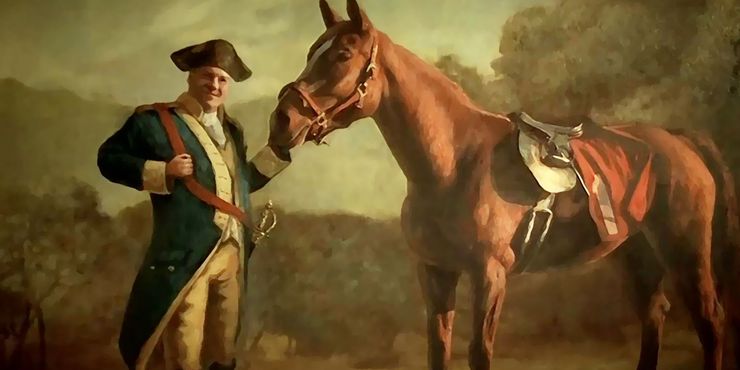This week, our friends @TheMERL used The Sopranos to talk about the history of cottagecore.
Today, we're following suit by exploring our full-length version of the Bayeux Tapestry through the lens of the history of art ....and Paulie Walnuts.
(thread)
https://twitter.com/TheMERL/status/1290590669157867520
Today, we're following suit by exploring our full-length version of the Bayeux Tapestry through the lens of the history of art ....and Paulie Walnuts.
(thread)
https://twitter.com/TheMERL/status/1290590669157867520
In The Sopranos season four, Tony becomes enamoured with a racehorse, Pie O My.
Tony commissions a portrait of himself and the horse, but by the time it's finished, [spoilers] have happened, he no longer wants it, and he asks for the painting to be destroyed.
Tony commissions a portrait of himself and the horse, but by the time it's finished, [spoilers] have happened, he no longer wants it, and he asks for the painting to be destroyed.
....only, it's not. Paulie Walnuts, Tony's enigmatic henchman, disregards Tony's order and keeps the painting instead.
'It would be an honour to hang his picture in my house,' Paulie says, describing it as 'museum-quality' (ironically, which we'll come to).
'It would be an honour to hang his picture in my house,' Paulie says, describing it as 'museum-quality' (ironically, which we'll come to).
After hanging it on his wall, Paulie worries that the portrait's contemporary style, depicting Tony in a suit, clashes with his décor (of not 'a modern look', he says).
So, Paulie has it altered, with 'a stronger chin' and 'a different suit [...] like a revolutionary general'.
So, Paulie has it altered, with 'a stronger chin' and 'a different suit [...] like a revolutionary general'.
Later, Tony visits Paulie's home & sees the painting on his wall. He's incensed, thinking it an insult & a joke.
After hearing Paulie's protestations that he sought to 'capture what [Tony's] all about' and honour him, Tony takes it down and puts it in the trash instead.
After hearing Paulie's protestations that he sought to 'capture what [Tony's] all about' and honour him, Tony takes it down and puts it in the trash instead.
Now, as a museum with an art collection, we're deeply interested in Paulie's curatorial praxis.
It's quite the flex, resolving to make an object fit an exhibition by (literally) changing it.
However, we're also interested in this in terms of art history and art theory.
It's quite the flex, resolving to make an object fit an exhibition by (literally) changing it.
However, we're also interested in this in terms of art history and art theory.
In the last century, several leading critics & theorists have written about the 'reproduction' of art: how the resonance of an artwork varies with the context in which it is framed, e.g. seeing a photo of Michelangelo's David on Instagram rather than in the Sistine Chapel.
One is Walter Benjamin, who wrote about 'mechanical reproduction' (e.g. photographic copies of paintings).
He says that original artworks have an aura, a ‘presence in time and space, its unique existence at the place where it happens to be’, which, in reproductions, is lost.
He says that original artworks have an aura, a ‘presence in time and space, its unique existence at the place where it happens to be’, which, in reproductions, is lost.
John Berger followed this in 'Ways of Seeing', when he wrote: 'The uniqueness of every painting was [...] the uniqueness of the place where it resided. [...] When the camera reproduces a painting, it destroys the uniqueness [...] its meaning changes'.
This is a great moment to bring into the thread (quite literally) our version of the Bayeux Tapestry: 70 threaded metres of astonishing artistry, embroidered in 1880s England by the thirty-five women of the Leek Embroidery Society in Staffordshire.
Its creation was the idea of Society member Elizabeth Wardle, who visited Bayeux in 1885 and saw the original.
The Society created the Tapestry over the course of a year, using the same techniques as the original.
Each embroiderer added their name beneath their section, e.g.
The Society created the Tapestry over the course of a year, using the same techniques as the original.
Each embroiderer added their name beneath their section, e.g.
While the embroiders didn't make changes directly onto the original (unlike rogue conservator Paulie Walnuts), there are differences between ours and the original. Particularly in some (private) areas: https://twitter.com/readingmuseum/status/1220645331412668416
A little like Paulie's handiwork, these conservative changes reflect the context in which the finished tapestry was (re)produced: the prim society of Victorian England.
In fact, the embroiderers based their work on drawings of the Bayeux Tapestry made by archivists at South Ken Museum (now the V&A). We believe it was these archivists who made the changes, which the embroiderers then followed from.
The war over culpability continues.
The war over culpability continues.
Either way, after flying from New Jersey to Bayeux and back again, we’re left reflecting on our Tapestry: how it isn't an exact, mechanical copy, and how glad we are it isn't.
Instead, it's a brilliant feat of imagination, an astonishing hommage and piece of art that's deeply personal to its creators, with an aura all of its own.
And during our closure we've missed it enormously.
And during our closure we've missed it enormously.
At this stage, we even have some sympathy for Paulie. If the New Jersey Museum of Gabagool ever needs a new art curator, then we dearly hope that up-and-coming critic Paulie Gualtieri will be considered for the post.
Learn more about Britain's Bayeux Tapestry at Reading Museum over on our website, and thank you for joining us on this most unexpected of forays on a very hot Friday afternoon indeed. https://www.readingmuseum.org.uk/your-visit/permanent-galleries/bayeux-gallery

 Read on Twitter
Read on Twitter





